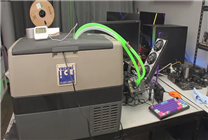Achieving Unprecedented Graphics Performance: RTX 5050 Overclocking Records Shattered
Key Takeaways:
- Overclocking aficionado, Trashbench, achieves a remarkable 23% frequency increase on the RTX 5050 GPU, reaching nearly 3.5GHz.
- Innovative cooling solution using a camping freezer allows for exceptional thermal management.
- This groundbreaking effort positions the RTX 5050 as the fastest GB207 core worldwide according to 3DMark rankings.
In a thrilling display of engineering and ingenuity, overclocking enthusiast Trashbench recently made headlines by pushing the limits of the RTX 5050 graphics card to unprecedented heights. Utilizing a unique cooling method, Trashbench managed to elevate the GPU’s core frequency to an impressive 3.5GHz, marking a staggering 23% increase over its default speed of 2820MHz. This achievement not only breaks numerous records but also sets a new benchmark in the world of hardware modification.
The Challenge
Trashbench took on this ambitious challenge as part of an entertaining competition dubbed "YouTube’s Dumbest Contest," in collaboration with fellow overclocker Clock Bench. The goal was simple: discover who could maximize the performance capabilities of the RTX 5050. Motivated by both friendly rivalry and a thirst for technological excellence, the contestants ventured into uncharted territory in the realm of overclocking.
Modifying the Hardware
To facilitate such an extreme increase in power, Trashbench employed a strategy known as shunt modification. This technique involved altering the sensing resistor on the GPU’s 12V line, thereby bypassing the card’s inherent power consumption limits. By fooling the card into misreporting its own power draw, he unlocked its full potential, setting the stage for a record-setting performance.
Innovative Cooling Solution
With power consumption no longer a limiting factor, the focus swiftly shifted to heat dissipation, a crucial element in sustaining overclocked speeds. Trashbench utilized a camping freezer filled with a 60/40 ethylene glycol mixture, creating a highly efficient cooling environment for the GPU. This innovative approach allowed for the effective management of temperatures, which were maintained between a chilling -12°C and 15°C throughout the testing process.
Achievements and Results
The results of this overclocking endeavor were nothing short of extraordinary. Trashbench achieved a stable core frequency of 3468 MHz, dramatically surpassing standard operating speeds. Despite the extreme modifications, the GPU reported power consumption at just 78W—a misleading figure due to the alteration made in the shunt modification process. Ultimately, the combination of innovative cooling and precise technical tuning propelled the RTX 5050 to the pinnacle of 3DMark’s performance rankings, establishing it as the fastest GB207 core globally.
Conclusion
This remarkable feat underscores the immense potential of overclocking and the willingness of enthusiasts to push technology to its limits. Trashbench’s innovative strategies not only set new records but also inspire the broader community of hardware modifiers and gamers alike. As technology continues to advance, the boundaries of performance will surely be tested and redefined, paving the way for future breakthroughs in GPU engineering.
The journey of the RTX 5050 from a standard graphics card to a record-breaking powerhouse exemplifies the spirit of innovation present in the overclocking community. As we look ahead, it will be exciting to witness the ongoing evolution of hardware modifications and the new heights they will reach.








